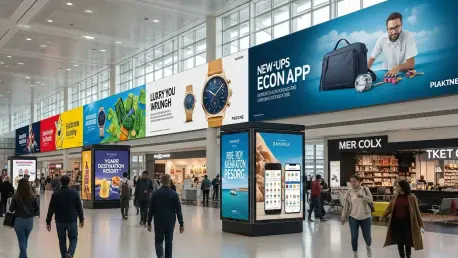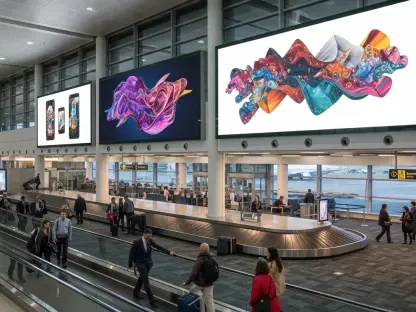Imagine a bustling motorway corridor where thousands of vehicles pass daily, each driver and passenger a potential viewer of vibrant, eye-catching advertisements strategically placed near major airports. This is the vision Transport for New South Wales (NSW) is bringing to life with an ambitious tender for out-of-home (OOH) advertising along the M12 Motorway and Sydney Gateway. These high-traffic routes, critical to Sydney’s transportation network, offer unparalleled visibility for brands aiming to capture diverse audiences. As the region’s infrastructure evolves, this initiative marks a significant opportunity for media owners and agencies to tap into fresh, high-value inventory while contributing to public service enhancements.
Overview of Outdoor Advertising in NSW
The OOH advertising industry in New South Wales stands as a vital component of the regional economy, generating substantial revenue through diverse formats across urban and suburban landscapes. Billboards, transit ads, and digital displays dot the state, delivering messages to millions of daily commuters and travelers. This sector not only supports brand outreach but also fuels economic activity by creating jobs in creative, technical, and operational fields, making it a cornerstone of modern marketing strategies in the area.
Transport for NSW plays a pivotal role with an extensive advertising portfolio that spans 798 station boards, 49 digital billboards, and placements on over 3,700 buses and 70 trams throughout Greater Sydney and beyond. Revenue from these assets directly supports public infrastructure, funding essential upgrades and maintenance while easing the financial burden on taxpayers. This symbiotic relationship between advertising and transport services underscores the importance of innovative partnerships in sustaining growth.
Key players, including prominent media owners and advertising agencies, drive competition and creativity within the market, while digital technologies have transformed traditional billboards into dynamic, interactive platforms. Real-time content updates and targeted messaging have elevated the impact of OOH advertising, aligning it with contemporary consumer behaviors. As technology continues to advance, the industry adapts, ensuring relevance in an increasingly digital world.
Strategic Expansion with Airport Corridor Opportunities
Key Trends and Benefits
The introduction of billboard sites along the M12 Motorway and Sydney Gateway heralds a new era for OOH advertising in NSW, capitalizing on proximity to major airports for maximum exposure. These corridors promise high-traffic visibility, reaching commuters, business travelers, and tourists alike, thus offering advertisers a unique chance to engage with a broad and varied audience. Such strategic locations amplify brand presence in areas of significant economic activity.
Beyond commercial gains, the revenue generated from these advertising spaces will be reinvested into the NSW Transport network, enhancing service quality, bolstering safety protocols, and reducing fiscal pressures on the public. This reinvestment model ensures that financial benefits translate into tangible improvements for commuters, reinforcing the value of public-private collaborations in infrastructure development.
Additionally, the initiative fosters local job creation within the advertising industry and related sectors, such as design, installation, and maintenance. This economic ripple effect aligns with broader community development goals, supporting livelihoods while beautifying and modernizing transport corridors. The dual focus on profitability and social good sets a precedent for future projects of this nature.
Market Potential and Growth Projections
Advertising along the M12 Motorway, linking to Western Sydney International Airport, and the Sydney Gateway, connected to Sydney Airport, holds immense potential due to their strategic positioning. With one corridor operational as of last year and the other expected by 2026, these routes are poised to capture significant audience reach, driven by growing airport traffic and regional expansion. Early data suggests a steady increase in vehicle numbers, promising sustained visibility for advertisers.
Traffic projections indicate robust growth in these areas, particularly with Western Sydney’s ongoing development and the rising importance of both airports as economic hubs. Audience demographics span a wide range, from local residents to international visitors, offering advertisers a diverse pool for targeted campaigns. This mix enhances the appeal of these greenfield sites as prime advertising real estate.
Looking ahead, these locations are expected to significantly boost Transport for NSW’s advertising portfolio over the next few years, from the current period to 2027. As infrastructure projects mature, the corridors could become flagship advertising hubs, setting benchmarks for reach and engagement. This forward-looking perspective highlights the long-term value of investing in such high-impact zones.
Challenges in Managing New Advertising Inventory
The operation of billboard sites in high-traffic airport corridors presents logistical complexities, particularly in installation and ongoing maintenance. Ensuring minimal disruption to traffic flow while adhering to tight project timelines demands meticulous planning and coordination. These challenges necessitate robust partnerships capable of navigating such operational intricacies with precision.
Competitive pressures within the OOH advertising market add another layer of difficulty, as numerous players vie for advertiser attention in a crowded space. Standing out requires innovative approaches, such as unique creative executions or premium site offerings, to secure brand investments. Transport for NSW must work with partners who can differentiate these new assets from existing inventory.
Potential solutions lie in embracing advanced technologies, such as dynamic digital displays that adapt content in real time, enhancing viewer engagement. Seamless integration with infrastructure projects also ensures that advertising structures complement rather than clash with transport aesthetics. Leveraging such strategies could mitigate challenges and position these sites as industry leaders.
Regulatory and Operational Framework
Transport for NSW has established clear licensing agreements for partners managing the new billboard sites, outlining expectations for end-to-end operations from design to execution. These agreements prioritize accountability, ensuring that selected organizations possess the expertise to handle high-visibility locations effectively. Such frameworks aim to maintain consistency and quality across all advertising initiatives.
Compliance with safety standards and environmental considerations remains paramount, especially given the proximity of these sites to critical airport corridors. Regulations mandate that installations avoid visual distractions for drivers and adhere to sustainability practices, minimizing ecological impact. Strict oversight ensures that these requirements are met without compromising project goals.
Regulatory mechanisms also guarantee that advertising efforts align with public interest and broader infrastructure objectives. By balancing commercial ambitions with community needs, Transport for NSW seeks to create a harmonious integration of advertising within transport networks. This structured approach fosters trust among stakeholders and upholds the integrity of public spaces.
Future Outlook for OOH Advertising in NSW
The M12 Motorway and Sydney Gateway hold promise as long-term advertising hubs, particularly as Western Sydney grows and airport traffic surges in the coming years. These corridors could redefine OOH advertising by setting new standards for visibility and impact in high-density areas. Their strategic importance is likely to attract sustained interest from major brands.
Emerging trends, such as data-driven targeting and interactive digital billboards, are expected to shape future strategies, offering advertisers precision in reaching specific demographics. These innovations could transform static displays into engaging platforms that resonate with modern audiences. Staying ahead of such trends will be crucial for maximizing the potential of these new sites.
Economic conditions, technological advancements, and ongoing infrastructure development will collectively influence the trajectory of OOH advertising in NSW. Adapting to these variables will determine how effectively the industry capitalizes on new opportunities. A proactive stance toward innovation and collaboration will likely define success in this evolving landscape.
Conclusion and Recommendations
Reflecting on the insights gathered, it becomes evident that Transport for NSW has laid a strong foundation for expanding its advertising reach through strategic airport corridor placements. The initiative showcases a commitment to blending commercial potential with public benefit, ensuring that financial gains support vital transport improvements. This balance strikes a chord with stakeholders seeking sustainable growth models.
Moving forward, potential partners should prioritize innovative advertising solutions, such as cutting-edge digital formats, to captivate audiences in these high-traffic zones. Emphasizing community-aligned initiatives, like local job support, could further enhance the social impact of these projects. Such efforts would amplify returns while fostering goodwill among residents and travelers.
Ultimately, collaboration with experienced organizations proves essential in maintaining high standards for these valuable sites. Transport for NSW should focus on building partnerships that bring technical expertise and creative vision to the table, ensuring long-term success. By embracing adaptability and forward-thinking strategies, the future of OOH advertising in these corridors holds immense promise for all involved.









